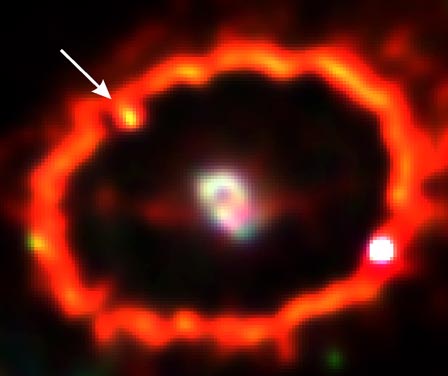Explanation: Eleven years ago the brightest supernova of modern times was recorded. Now the expanding debris from this tremendous stellar explosion is seen to be crashing into previously expelled material. The onset of this collision is shown by the arrow in the above picture as the yellow spot on the interior of the ring. Although the collision is occurring at speeds near 60 million km/hour, it will appear to take years due to the vast distances involved. As the supernova blast wave moves out, it shock-heats any gas it encounters, causing it to glow. Astronomers are thus hopeful that the blast wave will illuminate the interesting past of SN 1987a, and perhaps provide more clues about the origins of the mysterious rings.
1999 2000 2001 2002 2003 2004 2005 2006 2007 2008 2009 2010 2011 2012 2013 2014 2015 2016 2017 2018 2019 2020 2021 2022 2023 2024 2025 |
Yanvar' Fevral' Mart Aprel' Mai Iyun' Iyul' Avgust Sentyabr' Oktyabr' Noyabr' Dekabr' |
NASA Web Site Statements, Warnings, and Disclaimers
NASA Official: Jay Norris. Specific rights apply.
A service of: LHEA at NASA / GSFC
& Michigan Tech. U.
|
Publikacii s klyuchevymi slovami:
SN 1987a - supernova - Sverhnovye - udarnye volny - Mezhzvezdnaya sreda - ostatok Sverhnovoi
Publikacii so slovami: SN 1987a - supernova - Sverhnovye - udarnye volny - Mezhzvezdnaya sreda - ostatok Sverhnovoi | |
Sm. takzhe:
Vse publikacii na tu zhe temu >> | |
